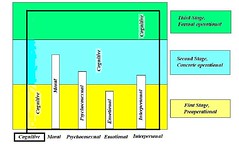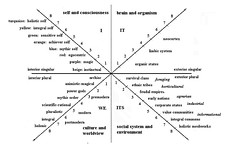Matrix of Vertical and Horizontal Health
It’s kind of funny how different things converge into your life and lead you down various thought trails. You’re welcome to follow my thought trails if you dare.
This week on Integral Naked, there was a particularly poignant video clip, “The Matrix of Health: Vertical Transformation, Horizontal Translation,” where Ken Wilber discusses developmental progression through the Integral model he uses making sense of all our experience. And also this week, Rebecca over at Epic Journeys blogged about a very similar topic, and my wheels started turning.
Rebecca asks the question: “I am very interested in how Postmodernism, abuse, and other crisis events change the way people develope. Hmmm, maybe ideas for a masters thesis. Who knows.”
My hope is that you, dear reader, are familiar with at least a basic understanding of developmental models by some of the following: Erik Erikson, Jean Piaget, Lawrence Kohlberg, Clare Graves, Don Edward Beck, Carol Gilligan, Jane Lovinger or James Fowler.
Rebecca wonders about Postmodernism and how it relates to the way we develop, and I too have that question. In Wilber’s Four Quadrant model (see the diagram below) on the left there is the progression that basically follows spiral dynamics, and according to Wilber these “orienting generalizations” account for not only individual and personal development, but for how societies and civilizations have developed through history. The upper left is singular and deals with “I” self and consciousness, the lower left is plural and deals with “We” culture and worldview. Interestingly enough Postmodernism is on the outer edge of the progression line, and includes characteristics such as pluralistic, integral, and holonic (for more on holonic see Wilber’s book, A Brief History of Everything). While this represents the cultural “We” on the development scale, the corresponding singular “I” is characterized by spiral dynamics levels of Green (the sensitive self) and Yellow (the integral self).
Any developmental model used to measure stages of growth, is fairly arbitrary much like the use of inches or centimeters is rather a matter of choice. Levels or stages measure something along a line. And the lines we look at for measuring development include cognition, moral, psychosexual, emotional, and interpersonal. Cognitive development is not the capacity for abstract thought, BUT the capacity to take perspectives. The cognitive line, as Wilber says, functions like a container for the other lines. On average human cognitive development in North
Progress along stages in our personal development requires that all the other intelligences have to live up to the potential that cognitive development has made available. We frequently run into people (and that includes ourselves) who have the cognitive capacity for 3rd person perspective, BUT on the interpersonal line, let’s say, they are stuck on 1st person, and just can’t get past the egocentric self centered me-me’s. In looking at this I finally understand my fellow emerging followers of Jesus, who have often leveled criticism at “individualistic” values. When seen in this light I wholly concur with them.
This impediment to developmental growth occurs when parts of subjectivity are split off, and this is what creates what Wilber calls ‘shadow’, a hidden subject, a sub-personality that retains the age and stage of when it split off. Not in an extreme clinical disassociation like schizophrenia or multiple personality, but maybe a mild neurotic form. Wilber warns that this ‘Darth Vader’ move to the dark side is possible all along the developmental spiral.
He has an excellent metaphor for explaining how this can impede our spiritual progress. Let’s say that at birth everyone is at square one, and whether you use the stages of spiral dynamics, or the Hindu seven Chakra system, there are two ways you can lose parts of yourself that may be required for continual growth. For sake of the metaphor let’s say you’re given $100 at birth, then you experience exterior oppression, horrible life conditions, trauma, repressions, etc. Even at the physical state you might lose (split off) 10% of yourself, seal it off by projecting and lose touch with it. Now you have only 90% in your account. As you move along the line you come to the second Chakra, emotional/sexual, maybe you’ve got stern repressive puritanical parents, or you’ve experienced horrible trauma, or often repression is self initiated, you seal off another 10 units of yourself, as a hidden sub-personality that is obsessed with sex. If it’s the first Chakra, the physical body, you have an eating disorder. Less and less feeling and awareness is available to you, and more parts of yourself are split off and appear as shadow, as an I that you don’t know as an I. And you’re limping along and maybe it takes 70 units to move into the next stage, and you’ve only got 60 left in your account, you just can’t quite get there. You glimpse it, but it will soon fade, and you just can’t seem to hold on to it. Shadow, the dark side, misinterprets your interior, and is lying to yourself. It’s like there’s a textbook of Hamlet, it’s in Russian, so somebody’s translating it for you, BUT they’re lying – that’s shadow. The Shadow reads your interior text and lies to you about what’s down there. So you have to go back and learn to reinterpret your feelings, recover the units stolen away from you, so that you can move on to the next horizon.
Learning to reinterpret your feelings, shedding light on shadow, illuminating the blind spots of ourselves is the work of spiritual discipline, practice and maybe therapy as well.









